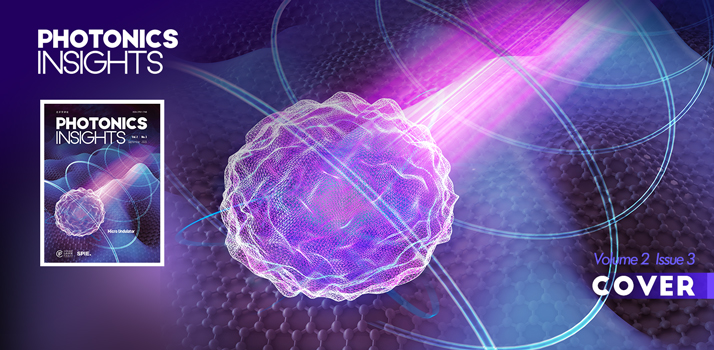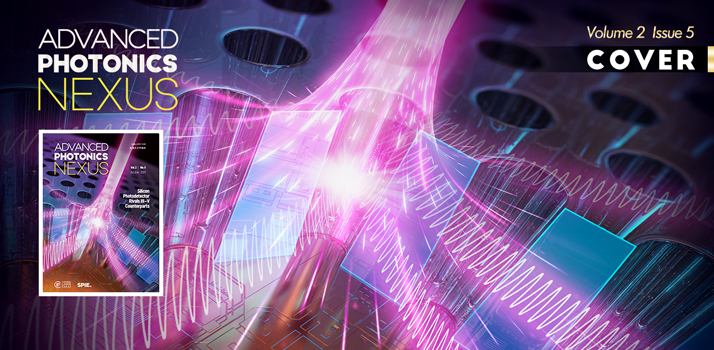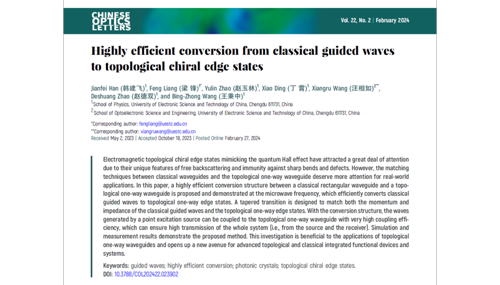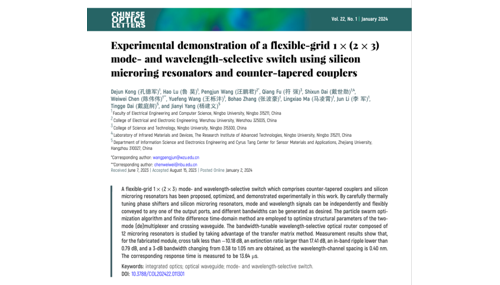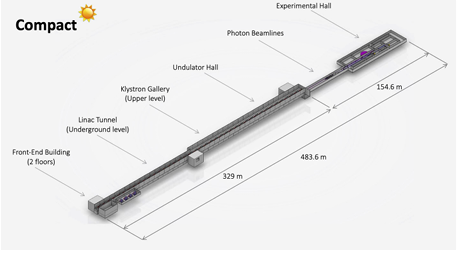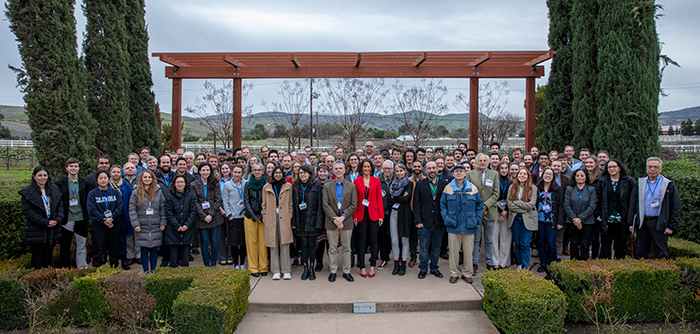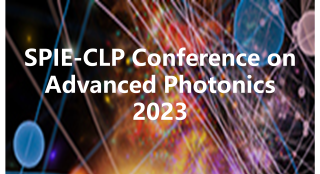- Apr. 19, 2024
- Vol. 22, Issue 2 (2024)
- Apr. 19, 2024
- Vol. 22, Issue 1 (2024)
- Apr. 18, 2024
- Vol. , Issue (2024)
- Apr. 16, 2024
- Vol. , Issue (2024)
- Apr. 11, 2024
- Vol. , Issue (2024)
Active metasurfaces have recently attracted more attention since they can make the light manipulation be versatile and real-time. Metasurfaces-based holog
Active metasurfaces have recently attracted more attention since they can make the light manipulation be versatile and real-time. Metasurfaces-based holography possesses the advantages of high spatial resolution and enormous information capacity for applications in optical displays and encryption. In this work, a tunable polarization multiplexing holographic metasurface controlled by an external magnetic field is proposed. The elaborately designed nanoantennas are arranged on the magneto-optical intermediate layer, which is placed on the metallic reflecting layer. Since the non-diagonal elements of the dielectric tensor of the magneto-optical material become non-zero values once the external magnetic field is applied, the differential absorption for the left and right circularly polarized light can be generated. Meanwhile, the amplitude and phase can be flexibly modulated by changing the sizes of the nanoantennas. Based on this, the dynamic multichannel holographic display of metasurface in the linear and circular polarization channels is realized via magnetic control, and it can provide enhanced security for optical information storage. This work paves the way for the realization of magnetically controllable phase modulation, which is promising in dynamic wavefront control and optical information encryption.show less
- Apr.20,2024
- Chinese Optics Letters,Vol. 22, Issue 4
- 043601 (2024)
We demonstrate the generation, spectral broadening and post-compression of second harmonic pulses using a thin beta barium borate (BBO) crystal on a fused
We demonstrate the generation, spectral broadening and post-compression of second harmonic pulses using a thin beta barium borate (BBO) crystal on a fused-silica substrate as the nonlinear interaction medium. By combining second harmonic generation in the BBO crystal with self-phase modulation in the fused-silica substrate, we efficiently generate millijoule-level broadband violet pulses from a single optical component. The second harmonic spectrum covers a range from long wave ultraviolet (down to 310 nm) to visible (up to 550 nm) with a bandwidth of 65 nm. Subsequently, we compress the second harmonic beam to a duration of 4.8 fs with a pulse energy of 0.64 mJ (5 fs with a pulse energy of 1.05 mJ) using chirped mirrors. The all-solid free-space apparatus is compact, robust and pulse energy scalable, making it highly advantageous for generating intense second harmonic pulses from near-infrared femtosecond lasers in the sub-5 fs regime.show less
- Apr.20,2024
- High Power Laser Science and Engineering,Vol. 12, Issue 2
- 02000e16 (2024)
Valley topological photonic crystals (TPCs), which are robust against local disorders and structural defects, have attracted great research interest, from
Valley topological photonic crystals (TPCs), which are robust against local disorders and structural defects, have attracted great research interest, from theoretical verification to technical applications. However, previous works mostly focused on the robustness of topologically protected edge states and little attention was paid to the importance of the photonic bandgaps (PBGs), which hinders the implementation of various multifrequency functional topological photonic devices. Here, by systematically studying the relationship between the degree of symmetry breaking and the working bandwidth of the edge states, we present spoof surface plasmon polariton valley TPCs with broadband edge states and engineered PBGs, where the operation frequency is easy to adjust. Furthermore, by connecting valley TPCs operating at different frequencies, a broadband multifunctional frequency-dependent topological photonic device with selectively directional light transmission is fabricated and experimentally demonstrated, achieving the functions of wavelength division multiplexing and add–drop multiplexing. We provide an effective and insightful method for building multi-frequency topological photonic devices.show less
- Apr.20,2024
- Advanced Photonics Nexus,Vol. 3, Issue 3
- 036004 (2024)
Lidar based on the optical phased array (OPA) and frequency-modulated continuous wave (FMCW) technology stands out in automotive applications due to its a
Lidar based on the optical phased array (OPA) and frequency-modulated continuous wave (FMCW) technology stands out in automotive applications due to its all-solid-state design, high reliability, and remarkable resistance to interference. However, while FMCW coherent detection enhances the interference resistance capabilities, it concurrently results in a significant increase in depth computation, becoming a primary constraint for improving point cloud density in such perception systems. To address this challenge, this study introduces a lidar solution leveraging the flexible scanning characteristics of OPA. The proposed system categorizes target types within the scene based on RGB images. Subsequently, it performs scans with varying angular resolutions depending on the importance of the targets. Experimental results demonstrate that, compared to traditional scanning methods, the target-adaptive method based on semantic segmentation reduces the number of points to about one-quarter while maintaining the resolution of the primary target area. Conversely, with a similar number of points, the proposed approach increases the point cloud density of the primary target area by about four times.show less
- Apr.20,2024
- Photonics Research,Vol. 12, Issue 5
- 904 (2024)
In the field of long-wave infrared (LWIR) thermal imaging, vital for applications such as military surveillance and medical diagnostics, metalenses show immense potential for compact, lightweigh
In the field of long-wave infrared (LWIR) thermal imaging, vital for applications such as military surveillance and medical diagnostics, metalenses show immense potential for compact, lightweight, and low-power optical systems. However, to date, the development of LWIR broadband achromatic metalenses with dynamic tunable focus, which are suitable for both coaxial and off-axis applications, remains a largely unexplored area. Herein, we have developed an extensive database of broadband achromatic all-As2Se3 microstructure units for the LWIR range. Utilizing this database with the Particle Swarm Optimization (PSO) algorithm, we have designed and demonstrated LWIR broadband achromatic metalenses capable of coaxial and off-axis focusing with three dynamic tunable states. This research may have potential applications for the design of compact, high-performance optical devices, including those with extreme depth-of-field and wide-angle imaging capabilities.show less
- Apr.20,2024
- Chinese Optics Letters,Vol. 22, Issue 8
- (2024)
Lasers from ¹I₆ to ³F₄ transitions were first demonstrated in a Pr³⁺:YLF crystal by inserting a birefringent filter. Output powers up to 2.44 W, 2.10 W, 2.01 W and 2.42 W were obt
Lasers from ¹I₆ to ³F₄ transitions were first demonstrated in a Pr³⁺:YLF crystal by inserting a birefringent filter. Output powers up to 2.44 W, 2.10 W, 2.01 W and 2.42 W were obtained at 691.7 nm, 701.4 nm, 705.0 nm and 708.7 nm. Their slope efficiencies were 19.8%, 16.5%, 15.8% and 19.4%, respectively. The Mx² and My² factors were measured to be 2.29 and 2.03 at 691.7 nm, 2.23 and 1.86 at 701.4 nm, 2.31 and 2.08 at 705.0 nm, and 2.41 and 2.04 at 708.7 nm, with corresponding power fluctuations of less than 5.3%, 5.6%, 5.8%, and 2.9%.show less
- Apr.20,2024
- Chinese Optics Letters,Vol. 22, Issue 8
- (2024)
In this work, we proposed and experimentally demonstrated a novel probabilistic shaping (PS) 64QAM-OFDM with low-density parity-check (LDPC)-coded modulation in a W-band RoF system using envelop
In this work, we proposed and experimentally demonstrated a novel probabilistic shaping (PS) 64QAM-OFDM with low-density parity-check (LDPC)-coded modulation in a W-band RoF system using envelope detection. The proposed PS scheme has the advantages of no complex multiplication and division operations and low hardware implementation complexity. In our experiments, the TS-BWDM-based PS-64QAM DMT signals with a rate of 28.3-Gb/s transmission over 4-m wireless + 45-km SSMF transmission can be achieved. The system performance is investigated under one LDPC code rates (3/4) and two PS parameter values (k=3 and 9). The experimental results show that the receiver power sensitivity and the system fiber nonlinear effect tolerance can be significantly improved compared with uniformly-distributed signals.show less
- Apr.20,2024
- Chinese Optics Letters,Vol. 22, Issue 8
- (2024)
Planar cameras with high-performance and wide field-of-view (FOV) are critical in various fields, requiring highly compact and integrated technology. Existing wide FOV metalenses show great pote
Planar cameras with high-performance and wide field-of-view (FOV) are critical in various fields, requiring highly compact and integrated technology. Existing wide FOV metalenses show great potential for ultra-thin optical components, but there are a set of tricky challenges like chromatic aberrations correction, central bright speckle removal, and image quality improvement of wide FOVs. In this paper, we design a neural meta-camera by introducing a knowledge-fused data-driven (KD) paradigm equipped with transformer-based network. Such paradigm enables the network to sequentially assimilate the physical prior and experimental data of the metalens, and thus can effectively mitigate the aforementioned challenges. An ultra-wide FOV meta-camera, integrating an off-axis monochromatic aberration-corrected metalens with a neural CMOS image sensor without any relay lenses, is employed to demonstrate the availability. High-quality reconstructed results of color images and real scene images at different distance validate that the proposed meta-camera can achieve ultra-wide FOV (> 100-degree) and full-color image with the correction of chromatic aberration, distortion and central bright speckle, and the contrast increase up to 13.5 times. Notably, coupled with its compact size (<0.13 cm3), portability, and full-color imaging capabilities, the neural meta-camera emerges as a compelling alternative for applications such as micro-navigation, micro-endoscopes, and various on-chip devices.show less
- Apr.20,2024
- Advanced Photonics
- Journal
- 14th Apr,2024
- Journal
- 14th Apr,2024

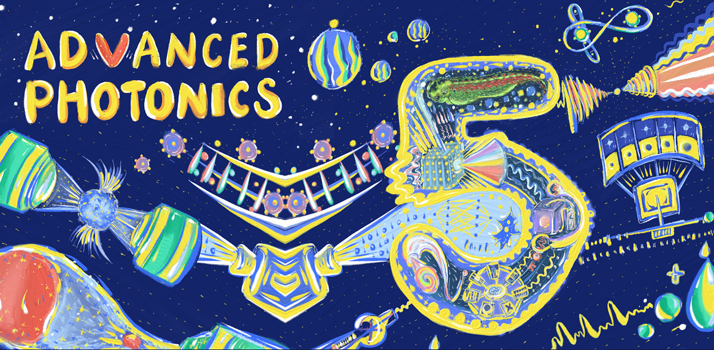
![On the Cover: Terahertz polarization sensing, chirality enhancement, and specific binding based on metasurface sensors for biochemical detection: a review [Invited]](/Post/images/2024/1/img_News_133491772873656281.jpg)

